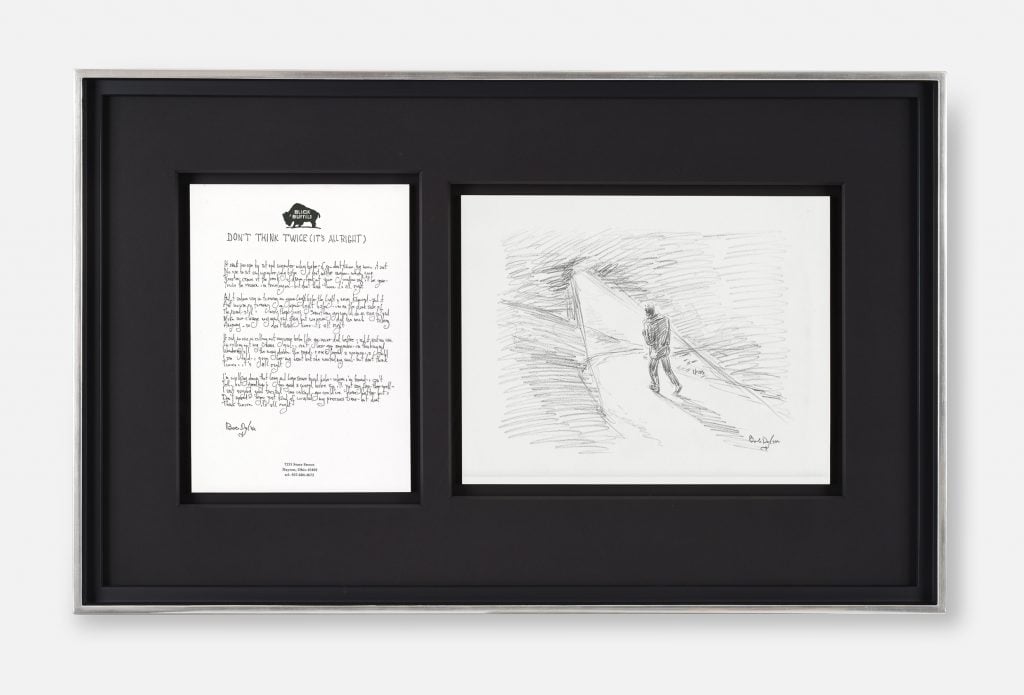Every Monday morning, Artnet News brings you The Gray Market. The column decodes important stories from the previous week—and offers unparalleled insight into the inner workings of the art industry in the process.
This week, separating fact from fiction…
CATALOG MODEL
Last Monday, Bob Dylan capitalized on nearly 60 years of indelible songwriting by selling the rights to his musical catalog to the Universal Music Publishing Group for an amount estimated to be upwards of $300 million. According to Ben Sisario of the New York Times, the deal “may be the biggest acquisition ever of the music publishing rights of a single songwriter.” What it is without a doubt, though, is another cannonball blasting through the myth that artists will be locked out of their discipline’s pantheon unless they abstain from actively commercializing their work.
The deal grants Universal control over more than 600 songs written and released by Dylan dating back to the early 1960s. It also encompasses multiple songs he cowrote with collaborators, as well as “a handful” of tracks by the Band (including “The Weight”) that he did not craft himself, yet somehow finagled the copyright to anyway. Dylan retains autonomy over his unreleased songs and future work.
The upshot of the agreement is that all revenue streams from Dylan’s back catalog now flow through Universal. The corporation wields the power to negotiate licensing agreements for the 600-pus songs’ usage in other media (such as film, TV, and advertising), and it receives all royalties generated when the songs are purchased, streamed, covered on record, and played in public forums (such as radio broadcasts, sports arenas, and other artists’ live shows).
Is there a direct art-market analog for Dylan’s epic cash-in? Not that I can find. The attributes and the business of visual art simply diverge too much from their musical equivalents for this deal to neatly map onto our niche industry.
However, I think contemporary artists can find a valuable lesson in the way Dylan handled his career in the decades leading up to this financial capstone: namely, that they shouldn’t wait to “sell out” if and when the opportunity comes along. Because Dylan’s full-blooded efforts to monetize his work for decades have had no negative impact whatsoever on his critical standing.

Bob Dylan at work in his studio. Photo courtesy MGM National Harbor.
SHELTER FROM THE STORM
As Sisario notes, hardcore Dylanites largely appear to have met news of his catalog sale with emotions ranging from resigned misery to visceral scorn. Their core problem is the prospect that Universal will take songs that have been deeply meaningful to them for decades and license them to anyone willing to pay top dollar, permanently polluting the aesthetic integrity of Dylan’s work.
Yet these reactions ignore the fact that, from a purist’s perspective, it would be difficult for Universal to license Dylan’s songs more fiercely or more dispassionately than he himself licensed them over the past quarter-century or so. Sisario calls back to the following inflection point:
In 1994, Dylan let the accounting firm Coopers & Lybrand—predecessor of the current giant PricewaterhouseCoopers—use Richie Havens’s rendition of his 1964 protest anthem “The Times They Are A-Changin’” in a TV spot. Fans, media commentators, and even other artists reacted in horror; Time magazine wrote about the controversy with the headline “Just in Case You Hadn’t Heard—The ’60s Are Over.”
In retrospect, the commercial opened the floodgates—and the corporate checkbooks. Dylan went on to license his songs in TV spots for Victoria’s Secret (2004), Apple (2006), Cadillac (2007), Pepsi (2009), Chrysler (2014), and IBM (2015).
Of course, these profit-conscious business decisions promptly and utterly demolished nearly six decades of his hard-earned credibility as a generational songwriting talent and cultural lodestar.
Just kidding—literally no one of consequence cared!
OK, that’s not completely true. Plenty of fans, pundits, and assorted cultural figures would have preferred if Dylan had just said no when these corporations came calling. But there is zero evidence his licensing spree damaged his reputation in music or the broader culture.
Today, Dylan has been showered with so many high-level honors that it borders on parody. In 2016, he was awarded the Nobel Prize in Literature. In 2008, he received a Special Citation of the Pulitzer Prize. Between those two laurel wreaths, he also earned the US National Medal of the Arts, the Presidential Medal of Freedom, and an honorary membership in the American Academy of Arts and Letters.
In the recording industry, he has been nominated for 39(!) Grammys, won 10 of those, and earned a Lifetime Achievement Grammy for good measure. He also won the Academy Award for Best Original Song in 2000. The Rock and Roll Hall of Fame inducted him all the way back in 1988. I could keep going, but you get the point.
It’s not as if this is a case of the cultural aristocracy breaking rank with the art form’s active practitioners and proletariat, either. Finding a songwriter who doesn’t regard Dylan as a master craftsman is still about as difficult as teaching a cat to parallel park an SUV.
Sure, the TV spots invited some snark and some heavy sighs. The same is probably true of Dylan’s 2019 collaboration with fashion line Barking Irons, which produced the Rolling Thunder capsule collection of “premium sportswear.” Ditto for his cofounding of Heaven’s Door, a Nashville distillery and soon-to-be art center crafting (according to a Dylan quote on the brand’s website) a “collection of American whiskeys that, in their own way, tell a story.”
But none of the licensing, merchandising, or other ancillary business deals that earned Dylan a net worth estimated to be in the hundreds of millions of dollars even before the Universal deal have made a dent in his reputation.
And you know what? That’s a good thing for artists everywhere, including those working in the white cube.

Bob Dylan, Don’t Think Twice, It’s All Right. Courtesy of Halcyon Gallery, London.
DON’T THINK TWICE, IT’S ALL RIGHT
If you consider yourself a part of the art industry, you might have read the previous section and thought, “Well, that might have been fine in music, but it would be different with galleries, museums, and collectors.” However, we don’t even have to look beyond Dylan himself to debunk this hypothesis.
As many readers know, Dylan has been exhibiting and selling his paintings, sculptures, and works on paper for much of this young century. In fact, London’s Halcyon Gallery is currently presenting “Bob Dylan: Editions,” a solo show that (despite the singular focus implied by its title) synthesizes his paintings, prints, sculptures, and handwritten lyric sheets accompanied by illustrations.
His CV also includes co-signs from some of the most esteemed gatekeepers in the art industry. Dylan’s artworks have been honored with at least a dozen solo shows in public collections around the world since 2007, most notably at London’s National Portrait Gallery and Milan’s Palazzo Reale. Dylan’s paintings and silkscreened canvases, respectively, were the subject of two separate solo exhibitions at Gagosian. (Although information about the shows and Dylan’s artistic CV remain accessible on the Gagosian website, a gallery spokesperson confirmed over the weekend that the dealer no longer works with Dylan.)
Nor are these works cheap novelties. In 2019, the US State Department acquired one of Dylan’s welded-steel sculptures for just over $84,000 as a part of its Art in Embassies program.
Critics could argue that Dylan’s traction in the upper echelons of the art world is an exception enabled only by the deep love some of the industry’s Boomer tastemakers feel for the man behind songs that soundtracked much of their adult lives.
But that’s the thing: if you really want to, you can always reverse-engineer a narrative to try to uphold the myth of the sellout. It just never holds up under scrutiny.
No one is better at selectively applying this story than the art world. To maintain the fiction that licensing and other mass-market commerce is lethal to artists’ credibility, we only tend to surface the cases where those endeavors either align with the core themes of the artist’s work or can be conveniently blamed on money-hungry estate executors: the Warhols, the Koonses, the Basquiats.

Niki de Saint Phalle’s Bénédicte (1965). Courtesy of wikimedia.
Conveniently forgotten are the canonical talents that fractured the supposed importance of creative purity. For example, in the late ‘60s, the celebrated postwar sculptor Niki de Saint Phalle licensed a line of inflatable pool toys based on her “Nanas”—the colorful, distorted female figures for which she is best known—and generated around $1.7 million in sales from hocking a signature perfume.
My fellow Artnet News columnist Kenny Schachter has noted that German Renaissance master Albrecht Dürer “sold editions out of his own shop,” “shipped copies of his prints ahead of his travels abroad to let his artwork build hype in advance of his arrival,” and twice battled for control of his copyright in court. A century later, Rembrandt “[bid] up his own prints at auction to buttress his prices”—an even more craven move than merchandising.
None. Of. It. Mattered.
The same story has played out in these cases and others over the centuries: as long as an artist performs their essential function well enough for long enough (and gets properly recognized for it), they are judged only by their central practice. The licensing deals, the branded merchandise, even the market manipulations become, at most, footnotes. Creating legitimately great work renders everything else irrelevant. In my mind, that is exactly the way it should be.
It’s also good news for artists struggling through a crisis year in an increasingly unforgiving, winner-takes-all gallery economy. It means they can fearlessly capitalize on nontraditional business opportunities without fear of meaningful critical backlash, even as some respected figures continue to flog purity-based scare tactics. Like so much else in art and life, the sell-out myth is ultimately little more than a mechanism for asserting and maintaining power over a class of people that deserve more than the traditional system has given them.
If you looked hard enough, there was plenty of evidence for this theory before Bob Dylan’s big score last week. But his Universal deal and his commerce-forward late career as a whole are much stronger reinforcements of its counterintuitive wisdom than any that the niche art world could ever muster. I hope more artists absorb them for what they are: the latest proof that warnings of selling out are just idiot wind.
[The New York Times | Rolling Stone]
That’s all for this week. ‘Til next time, remember the old adage when opportunity knocks: you might look stupid dancing, but you definitely look stupid not dancing, so you might as well dance.










